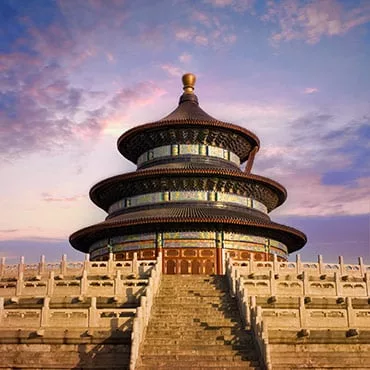
Forbidden City: Things to do in Beijing, China
Locals call the Forbidden City Gu Gong (故宫), which literally translates as ‘former palace’. Considering the Chinese penchant for highly descriptive names, ‘former palace’ is a decidedly unimaginative moniker for what many consider the most marvelous of all China’s ancient buildings.
The Forbidden City holds great appeal for any history enthusiast. Within its walls, you will gain special insights to the life and times, not only of China, but of the million or so who built it, and those who lived and worked within its walls.
Zijincheng (紫禁城) or Purple Forbidden City, as it is also known, most definitely appears to fit the bill as a city. It is the largest palace in the world, covering a total area of 720,000m2, and in 1987, UNESCO designated it as a World Heritage site. As the celestially ordained home of the emperor, the palace was a no-go zone for outsiders, hence the term ‘forbidden’. To risk entry was to risk life, however restrictions have eased greatly since empirical occupation and tickets for visitors today range between ¥40 and ¥60.
For a western traveler making their foray into the Forbidden City, it’s quite easy to feel overwhelmed and have no idea of where to start, so with that in mind, we’ve done our best to curate this ‘how to’ guide for a visit to this one-time home of rituals, riches, and often thwarted romance.

Forbidden City: Important facts
Let’s start with some Forbidden City facts.
Clearly, Yongle Emperor, the third Ming dynasty emperor, thought carefully about his decision to locate the palace in Beijing’s heart; auspiciously on the city’s central axis. His safety concerns – something every emperor faced – prompted him to move his court from Nanjing to Beijing and so building commenced in 1406. In keeping with this theme of ‘prevention is best’, the palace was designed to be impenetrable from the outside, with every conceivable eventuality considered in the design.
As with a great many historical projects of scale in China, the Forbidden City absorbed a massive workforce, said to have reached a million laborers and 100,000 artisans during its 14 -year construction. Preparation work that included collection of precious timbers and stone took eleven years, while specifically designed pavers and bricks were made in Suzhou and Linqing. Perhaps in the context of the palace’s longevity these can be seen as reasonable investments. The imperial palace served as the residence and court of 14 Ming dynasty emperors and 10 Qing dynasty emperors between 1420 and 1911. While restoration is a permanent activity at the Forbidden City, the longevity of the buildings and surrounds are a testament to the foresight and technical acumen of those involved in its design and construction.
Exploring the palace complex: Allow at least a day

The palace complex is a rectangle, surrounded by a 10 meter high wall and moat that stretches for a phenomenal 52 meters. From north to south, it extends 961 meters, and from east to west, 753 meters. When a survey of the entire palace complex was undertaken in 1973, it identified over 90 compounds, 980 buildings, and 8,728 rooms. In reality, the Forbidden City was a city within a city.
A large gate dominates each of the rectangle’s four walls.
| South | Meridian Gate (Wu Men) |
| North | Gate of Divine Prowess (Shenwu Men) |
| East | East Prosperity Gate (Donghua Men) |
| West | West Prosperity Gate (Xihua Men) |
Each gate was designated to a specific group of people while the palace was inhabited, however since 2011, visitors may enter only via the south gate (Wu Men), but can exit via the north (Shenwu Men) and east (Donghua Men) gates. Each corner of the palace’s perimeter is distinguished by a uniquely designed watchtower or jiao lou.

The Meridian gate (south) was the main entry and is really a complex or superstructure of buildings with arches or doorways. The buildings are referred to as the ‘Five Phoenix Turrets’. Almanacs and announcements were issued from the gatehouse.
Forbidden City: Halls and hallmarks
The palace comprises two main parts; the outer court is south, while the inner court is located in the north. The outer court is where the emperor held court and grand audiences. After stepping through the Meridian Gate, you immediately see a large square with five marble bridges arching over the man-made Golden Water River.
The Gate of Supreme Harmony is fronted by two giant bronze lions. Charged with the task of guarding the palace, the lions stand 4.4 meters high. The lion on the left (as you face it) is a male with its paw placed on an embroidered wall. A female lion guards from the opposite side and has its left paw on a lion cub, a symbol of the royal family’s prosperity.

Located behind the gate is Supreme Harmony Square. Three magnificent buildings stand on the tiered marble terrace.
| Hall of Supreme Harmony (Taihe Dian) | Important ceremonies held here, including crowning the emperor, birthday, wedding, Chinese New Year |
| Hall of Central Harmony (Zhonghe Dian) | Where the emperor rested or met officials prior to ceremonies |
| Hall of Preserving Harmony (Baohe Dian) | Where the emperors of the Ming dynasty changed their formal clothes before ceremonies. During the Qing dynasty it was used for banquets attended by nobility and high ranking officials. Imperial examinations were also held here. |
As is characteristic of the Forbidden City, there are many design features rich in symbolism. Along the marble terraces of the halls, there are 1,142 dragon heads. Of course, these are highly decorative, however they have a dual function as water drainage. Rainfall flows through the dragons’ mouths into an underground tunnel, where it meets the mouth of man-made Golden Water River located at the south end of the palace. This ingenious design prevents the Forbidden City from ever flooding.
Why no trees?

Apart from the sheer size of the palace, many visitors are struck by the complete absence of trees in the vast area that spreads out in front of the Gate of Supreme Harmony. There are commonly cited theories with fire prevention being the first of these, because many buildings and structures are made of timber. In fact, 308 giant bronze vats are located all around the palace, making it possible to put out fire, if needed.
A second reason was more aesthetic. The expansive area provided the ideal stage on which the majesty and grandeur could be showcased. The emperor’s life was always precariously in the balance, with the threat of assassins ever present. By limiting the places to hide, the emperor could also feel safe in the knowledge the 15 levels of pavers and bricks (carefully arranged in alternating horizontal and vertical layers) would prevent even the most ardent of threats from digging deep and tunnelling their way into the palace. The ‘five element’ theory is also floated as a reason no trees are planted here.
Who lived at the Forbidden City?

The northern part of the Forbidden City is the Inner Court. It is here you would have found the emperor and his consorts in residence, as well as venues for religious rituals and administration. In this area, there are also three main buildings located on the area’s central axis (and center).
| Palace of Heavenly Purity (Qianqing Gong) | Official residence of the emperor. Later became the place emperors conducted routine government business and celebrated major festivals and rituals |
| Hall of Union (Jiaotai Dian) | Where the empress received greetings from her high-ranking subjects on major festivals |
| Palace of Earthly Tranquility (Kunning Gong) | Residence of the Empress. Was also once the Shamanism sacrificial hall and imperial bridal chamber |
On both sides of the main axis were the Six Eastern Palaces and Six Western Palaces, which were the private residences of the imperial consorts and concubines. At the far end of the Inner Court, you will find the Imperial Garden, enormous at 10,000m2, and on each of its sides are the residences that housed the imperial princes and princesses.
Many westerners are curious about the number of imperial consorts and concubines kept by an emperor. This number varies, however Emperor Kangxi, China’s longest reigning emperor (61 years from 1661 to 1722), had four empresses and over 40 consorts, concubines, noble ladies and mistresses.
Emperor Yongzheng, the Qing Dynasty’s fourth emperor, resided and presided over state affairs in the Hall of Mental Cultivation (Yangxin Dian). Empress Dowager Cixi and Cian managed state affairs here – but behind the scenes – for Emperors Tongzhi and Guangxu. And it was in the Hall of Mental Cultivation that China’s last emperor Puyi abdicated from the throne after the 1911 revolution broke out. While Puyi was allowed to live in the Inner Court after his abdication, in 1924 he was expelled, and a committee was established to take over the palace and care for the vast collection of imperial treasures which number over 1.8 million individual pieces. The now famous Palace Museum was opened to the public in 1925, just one year after Puyi’s departure.
Palace Museum: A treasure in its own right
It is said that just over 40 percent of China’s valuable cultural relics are housed at the Palace Museum. Including a vast selection of bronze, ceramic, and jade pieces, as well as paintings, calligraphy, palace objects, and ancient books, only a relatively small number are displayed in more than ten galleries at the museum.

It’s an understatement to say the Palace Museum is immensely popular. Ranked as the most visited museum in the world, a daily limit of 80,000 visitors was set in 2015 to improve the experience and to support preservation efforts.
If possible, time your visit to spring or autumn, before the summer crowds flock and Beijing is deep in the throes of its typically icy winter. International travelers must provide their passport name and number when booking tickets, which should be purchased in advance rather than on the day to help with a speedy entry. You must present your passport on entry in exchange for a ticket bearing a QR code.
| Entry Prices | ||
| Adults | 1 Apr – 31 Oct | ¥60 |
| 1 Nov – 31 Mar | ¥40 | |
| Treasure Gallery | ¥10 | |
| Hall of Clocks | ¥10 | |
| Children | 6 – 18 years | Half price |
| Children | Under 1.2 meters and < 6 years | Free |
| Food | Yes | Various food and beverage outlets both inside and outside the Forbidden City. Our local insider tip? Ask your guide for directions to the Forbidden City’s Hidden Ice Restaurant: Bingjiao Cafe |
| Transport | Yes | Bus, subway and taxi (no parking) |
| Tours | Yes | Fully guided including transport to the base |
| Family friendly | Yes | |
| Close to city | Yes | |
| Opening hours | 1 Apr – 31 Oct | 8.30am – 5.00pm |
1 Nov – 31 Mar | 8.30am – 4.30pm |
Enjoy the opportunity to get up close with China’s imperial history with a visit to the Forbidden City. Make the most of your travel time with a guided tour and discover all the mystery, intrigue, and beauty within the four walls of the palace. Few places captivate in the way the Purple Palace does, so let us help make it the beautiful travel memory it should be. We can assist with bookings and travel arrangements for a single day tour of the Forbidden City – or a multi-destination adventure across China. Reach out here and we’ll respond within 24 hours.




 Great tour with Linda in Beijing
Great tour with Linda in Beijing





